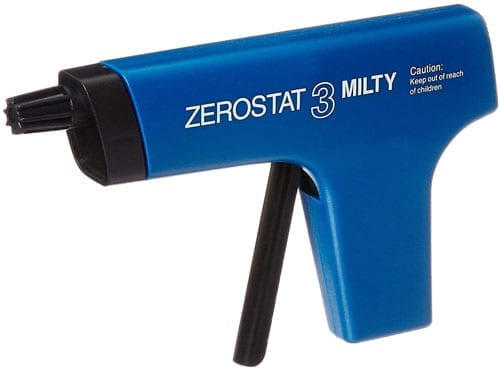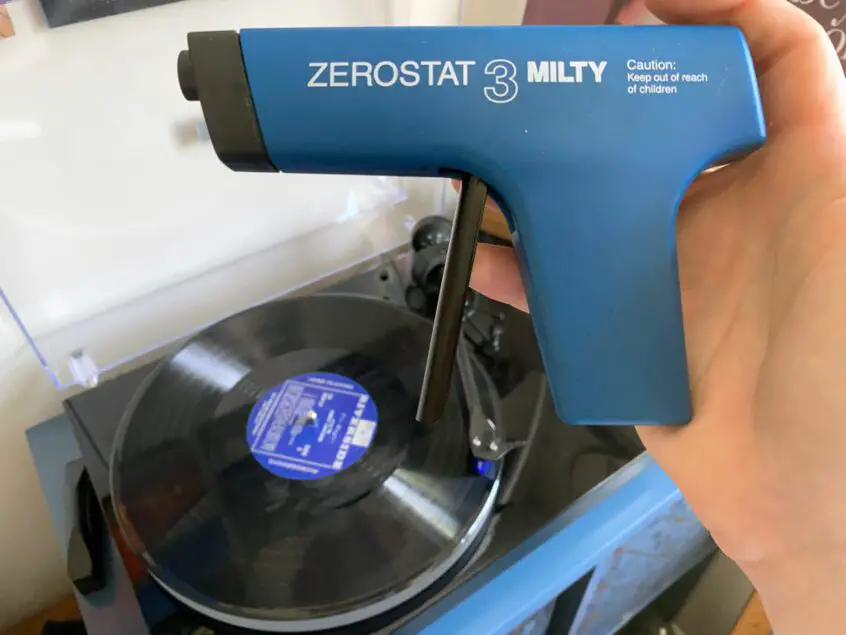For vinyl collectors, statically charged records are a persistent thorn in the side. When a vinyl record becomes statically charged, it acts like a magnet for any dust lurking near its vicinity, making it near-impossible to keep the record clean.
Watch our video below or a full demonstration or continue reading to learn more.
The problem is most acute in dry climates when the humidity is low; this is because the surface moisture on materials makes for a good conductor. If you live in a more humid, damp environment (like where I live in Britain) you might find static less troublesome. However, it’s all by degrees, and the severity of the issue depends on many environmental factors – from climate to household furnishing, and much more.
Frustratingly, record players and records are highly prone to static. Everything from the vinyl material itself, to the process of spinning a record; even pulling the record from its sleeve will contribute to static build up over time. Once a record becomes positively charged, it will attract dust and dirt onto the playing surface, causing pops and clicks. In addition, static records can also suffer from further overall noisefloor issues due to the electronic discharge of surface charge buildup.
New records are the biggest headache for me — most of which ship contaminated with static straight from the factory. Ironically, the higher quality and thicker the vinyl, the more prone to static the record will be — meaning those lovely thick 180g modern pressings are particularly troublesome.
How to remove static from vinyl records?
There are many methods and products used to control static (far too many to cover fully in this article, but here are some basics).
- You can help control static build-up by investing in a good carbon fiber brush (I like the Audio Quest model).The conductive carbon fiber strands help to discharge static while also clearing loose particles and dust from the record.
- Anti-static sleeves are a very worthwhile investment (I like the MoFi-style rice paper sleeves and these great North American-made options from Vinyl Storage Solutions). These help reduce static build up and better protect the record from damage (particularly when pulling the record out of the sleeve).
- Wet cleaning your records will remove static from your record. (Moisture is a great conductor). I use GrooveWasher as my day-to-day record cleaner.

However, if static is particularly problematic, you can combine the above methods with regular use of an antistatic gun (such as the Milty Zerostat). This will reduce the amount of contact with the record from excessive cleaning and may help to keep the record in better condition for longer.
At first glance, the Zerostat looks more like a child’s toy than a serious piece of maintenance kit, but behind the novelty-like facade is some serious science.
This anti-static gun incorporates a Piezo Crystal device that produces negative and positive ions that couple with the positive and negative static charges on the record surface to neutralize static. It sounds like witchcraft—but it really works.
How to use the Milty Zerostat
Hold the Zerostat within 12 inches (30cm) of the record surface. The record must be in free space, or the process will not work as efficiently.
Slowly squeeze the trigger to emit a stream of positively ionized air over the target surface. (If the trigger clicks, you’re pressing too fast).
Next, slowly release the trigger to release negative air ions and neutralize static presence. You may want to repeat this procedure at different points across the surface if necessary.
The Zerostat does not require batteries, and it’s good for approximately 50,000 squeezes. (That’s plenty to last a significant amount of time!) If you need to test the gun, simply attach the included ion indicator to the end of the pistol and squeeze the handle. If all is well, the attachment will glow red.
Summing things up
On first impression, it’s easy to dismiss the Milty Zerostat as a frivolous accessory. After all, you could just wet clean your records and avoid shedding out the best part of $100. However, the reality is, if the record doesn’t need wet cleaning to remove stubborn dirt and grime, it’s actually safer (not to mention quicker) to use a tool like Zerostat as it requires zero contact with the record surface. Additionally, you will find that by using an antistatic gun at the first sign of mild static charge, you’ll actually reduce the amount of required wet cleaning in the long run.
The Zerostat requires some investment upfront, but when combined with good quality anti-static sleeves and a general understand of best-practice record care it’s an essential tool in the arsenal of any record collector with static woes. Collectors that live in very dry climates with low-humidity will benefit from keeping the Zerostat close to their turntable to help nip static in the bud before it gets out of hand.




Geez, I remember when the original version cost $20 and that was about 40 years ago, I don’t think inflation went up anywhere near that percentage of increase they now want for that gun.
I have a Zerostat purchased around 1970. Stereo shop where purchased instructed me to use the device with the record on the TT and rotating. It must be working at least somewhat as when I don’t use it I will often hear a static pop when the stylus touches the vinyl.
[…] works on the record surface to neutralize static. I know, it sounds like witchcraft, but it works. (Check out our full review with GIF images to demonstrate the […]
Where there any audible differences when you used the Zerostat compared to when you didn’t?
I have a Zerostat Gun and can heartily recommend it! Works brilliantly!